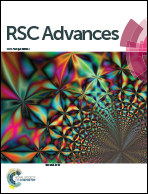Design and characterization of gadolinium infused theranostic liposomes
Abstract
Multifunctional theranostic gadolinium infused liposomes containing the chemotherapeutic drug, doxorubicin (DOX), in its core are designed as potential candidates for diagnosis and therapy of various cancers. In these theranostic liposomes, Gd3+ ions are chelated by the macrocyclic chelator 1,4,7,10-tetraazacyclododecane-1,4,7,10-tetraacetic acid, which is covalently linked to the hydrophilic head moiety of the phospholipid. Therefore, the Gd3+ labels are an integral part of the lipid bilayer of liposomal construct. The physical properties of the Gd-infused liposomes were characterized including drug loading, drug release kinetics, cellular consequences, and T1 weighted magnetic properties. The theranostic liposomes exhibits uniform size distribution (hydrodynamic size of 150 ± 10 nm) and a high drug loading efficiency with sustained drug release characteristic. Due to stable Gd3+ in their lipid bilayers, the theranostic liposomes displayed an enhanced r1 relaxivity of 12.3 mM−1 s−1 at 14.1 T, which is three times higher than that of currently used Gd-based contrast agent (Magnivest®: 4.1 mM−1 s−1, 1.4 T). Moreover, cellular uptake studies revealed that these theranostic liposomes exhibit higher structural integrities inside B16-F10 melanoma cells. It shows uniform intracellular distribution throughout the cells. In vitro cytotoxicity revealed that Gd-infused liposomes have excellent biocompatibility without significant cytotoxicity, whereas they showed higher cellular toxicity when loaded with DOX against B16-F10. The observed toxicity was equivalent to the same concentration of free DOX. With regard to the ongoing development in theranostic water-dispersible nanoformulations, the current formulation where Gd3+ ions are encapsulated by a macrocyclic chelator and covalently tethered to the hydrophilic head moiety of a lipid, is rather promising and holds great promise.


 Please wait while we load your content...
Please wait while we load your content...